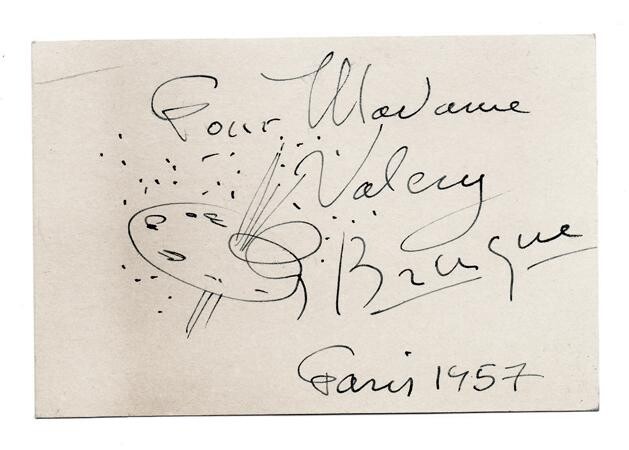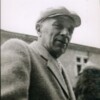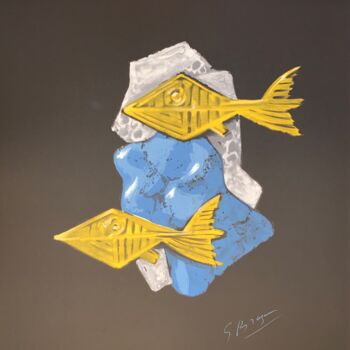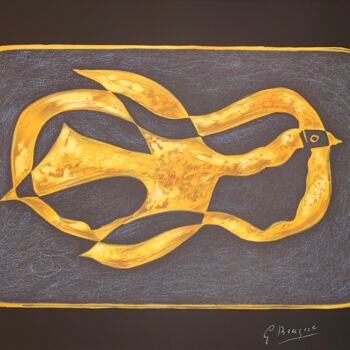Palette and brushes (2010) Painting by Georges Braque
Not For Sale
Sold by Images
We are sorry, the image file we have for this artwork is too small.
Please contact us with all your project's details and we will find a solution with you.
Contact Us
-
Original Artwork
Painting,
- Dimensions Height 3.2in, Width 4.7in
Note: The piece is dedicated “Pour Madame Valery”. Almost certainly this lady was the wife of the famous writer and intellectual, Paul Valery (1871 - 1945) (see also ) who was a great friend of Braque, Picasso and many other members of the “School of Paris” . Paul Valery was born of a Corsican father and Genoese mother in Sète, a town on the Mediterranean coast of the Hérault. Though his earliest publications date from his mid-twenties, Valéry did not become a full-time writer until 1920. After his election to the Académie française in 1925, Valéry became a tireless public speaker and intellectual figure in French society, touring Europe and giving lectures on cultural and social issues as well as assuming a number of official positions eagerly offered to him by an admiring French nation. He represented France on cultural matters at the League of Nations, and he served on several of its committees. The Outlook for Intelligence (1989) contains English translations of a dozen essays resulting from these activities. During World War II the Vichy regime stripped him of some of these jobs and distinctions because of his quiet refusal to collaborate with Vichy and the German occupation, but Valéry continued, throughout these troubled years, to publish and to be active in French cultural life, especially as a member of the Académie française. In 1900, he married Jeannie Gobillard, a friend of Stéphane Mallarmé's family, who was also a niece of the painter, Berthe Morisot. The wedding was a double ceremony in which the bride's cousin, Morisot's daughter, Julie Manet, married the painter, Ernest Rouart. Valéry and Gobillard had three children: Claude, Agathe, and François.
Size: 120 x 80 mms (Paper size)
Condition: Minor toning otherwise in good condition.
Authentication: We have no documentation to prove this is authentic. However the signature, style and composition of the work seem absolutely correct and similar to pieces of known authenticity and provenance which we have seen.
Related themes
Georges Braque was a French artist who played a pivotal role in the development of Cubism, one of the most influential movements in 20th-century art. Born on May 13, 1882, in Argenteuil, France, Braque initially studied painting at the École des Beaux-Arts in Le Havre before moving to Paris to pursue his artistic career further.
In Paris, Braque encountered the works of Paul Cézanne and the Fauvists, whose bold use of color and innovative approach to composition would greatly influence his early artistic development. However, it was his collaboration with Pablo Picasso in the early 20th century that would define his legacy.
Braque and Picasso worked closely together, experimenting with new ways of representing form and space in art. Together, they developed Cubism, a revolutionary movement that sought to depict the world from multiple viewpoints simultaneously, breaking objects down into geometric shapes and reassembling them in abstract compositions.
Braque's contributions to Cubism were significant, particularly in the development of what became known as Analytical Cubism, characterized by its monochromatic palette and fragmented forms. He often used collage techniques, incorporating materials such as newspaper clippings and printed text into his paintings to further disrupt traditional notions of representation.
During World War I, Braque served in the French army, an experience that deeply impacted his work and led to a shift towards a more subdued color palette and a greater emphasis on still-life subjects.
After the war, Braque continued to explore new artistic avenues, experimenting with different styles and techniques while maintaining his commitment to abstraction and geometric form. He also ventured into sculpture, producing a series of innovative works that reflected his interest in volume and space.
Throughout his career, Braque received numerous accolades and honors, including the Grand Prix at the Venice Biennale in 1963. He passed away on August 31, 1963, leaving behind a rich and diverse body of work that continues to captivate and inspire audiences around the world. Today, Georges Braque is celebrated as one of the pioneering figures of modern art, whose contributions to Cubism and artistic innovation have left an indelible mark on the history of art.
-
Nationality:
FRANCE

- Date of birth : unknown date
- Artistic domains: Represented by a Gallery,
- Groups: Contemporary French Artists Artists presented by a gallery








